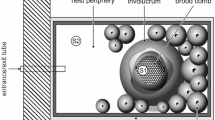Summary
Temperate species of the Drosophila melanogaster group enter reproductive diapause for overwintering in response to short daylength. During the prediapause period they accumulate triacylglycerols, but not glycogen, as energy resources. The capacity for storing triacylglycerols differs between species, and appears to be closely correlated with diapause and cold-hardiness; cool-temperate species, such as those of the auraria species complex, which enter a deep diapause and are highly cold-hardy, accumulate larger quantities of triacylglycerols than warm-temperate species, such as D. rufa and D. lutescens, which enter a weak diapause and are less cold-hardy. Among the cool-temperate spcies, D. subauraria occurs at a higher latitude and has the greatest capacity for accumulating triacylglycerols. A subtropical species, D. takahashii, which has no diapause in nature and is not cold-hardy, is unable to store the same quantities of triacylglycerols as temperate species.
Similar content being viewed by others
References
Beenakers AMT, Van der Horst DJ, Van Marrewijk WJA (1981) Role of lipids in energy metabolism. In: Downer RGH (ed) Energy metabolism in insects. Plenum Press, New York, pp 53–100
Clark AG, Gellman W (1985) A rapid spectrophotometric assay of triglycerides in Drosophila. Drosophila Information Service 61:190
Clark AG, Keith LE (1988) Variation among extracted lines of Drosophila melanogaster in triacylglycerol and carbohydrate storage. Genetics 119:595–607
Clark AG, Keith LE (1989) Rapid enzyme kinetic assays of individual Drosophila and comparisons of field-caught Drosophila melanogaster and D. simulans. Biochem Genet 27:263–277
Downer RGH, Matthews JR (1976) Patterns of lipid distribution and utilization in insects. Am Zool 16:733–745
Kimura MT (1982) Cold hardiness and preimaginal period in two closely related species, Drosophila takahashii and D. lutescens. Kontyû 50:638–648
Kimura MT (1984) Geographic variation of reproductive diapause in the Drosophila auraria complex (Diptera: Drosophilidae). Physiol Entomol 9:425–431
Kimura MT (1987) Habitat differentiation and speciation in the Drosophila auraria species complex (Diptera: Drosophilidae). Kontyû 55:429–436
Kimura MT (1988a) Adaptations to temperate climates and evolution of overwintering strategies in the Drosophila melanogaster species group. Evolution 42:1288–1297
Kimura MT (1988b) Interspecific and geographic variation of diapause intensity and seasonal adaptation in the Drosophila auraria species complex (Diptera: Drosophilidae). Funct Ecol 2:177–183
Kimura MT (1988c) Male mating activity and genetic aspects in imaginal diapause of Drosophila triauraria. Entomol Exp Appl 47:81–88
Kimura MT (1990) Quantitative response to photoperiod during reproductive diapause in the Drosophila auraria species complex. J Insect Physiol 36:147–152
Lambremont EN, Blum MS, Schrader RM (1964) Storage and fatty acid composition of triglycerides during adult diapause of the boll weevil. Ann Entomol Soc Am 57:526–532
Lemeunier F, David JR, Tsacas L, Ashburner M (1986) The melanogaster species group. In: Ashburner M, Carson HL, Thompson JN Jr (eds) The genetics and biology of Drosophila, vol 3e. Academic Press, London, pp 147–256
Pullin AS (1987) Adult feeding time, lipid accumulation, and over-wintering in Aglais urticae and Inachis io (Lepidoptera: Numphalidae). J Zool 211:631–641
Storey KB (1983) Metabolism and bound water in overwintering insects. Cryobiology 20:354–379
Stryer L (1981) Biochemistry, 2nd edn. Freeman, San Francisco
Sun GY, Brookes VJ (1968) The deposition of lipid and the composition of neutral lipids in the fat body of Sarcophaga bullata (Diptera). Comp Biochem Physiol 24:177–185
Tauber MJ, Tauber CA, Masaki S (1986) Seasonal adaptations of insects. Oxford University Press, New York
Valder SM, Hopkins TL, Valder SA (1969) Diapause induction and changes in lipid composition in diapausing and reproducing faceflies, Musca autumnalis. J Insect Physiol 15:1199–1214
Wigglesworth VB (1949) The utilization of reserve substances in Drosophila during flight. J Exp Biol 26:150–163
Williams CM, Barness LA, Sawyer WH (1943) The utilization of glycogen by flies during flight and some aspects of the physiological aging of Drosophila. Biol Bull 84:263–272
Author information
Authors and Affiliations
Rights and permissions
About this article
Cite this article
Ohtsu, T., Kimura, M.T. & Hori, S.H. Energy storage during reproductive diapause in the Drosophila melanogaster species group. J Comp Physiol B 162, 203–208 (1992). https://doi.org/10.1007/BF00357524
Accepted:
Issue Date:
DOI: https://doi.org/10.1007/BF00357524




